2024 Royal Enfield Shotgun 650 Review – First Ride
Born of creative chaos
In the past six years since Royal Enfield launched its first 650cc twin-cylinder bikes of the modern era in the 2018 model year, the well-developed, well-built and well-priced Interceptor and Continental GT have catapulted the Indian manufacturer into a leading role in the global middleweight motorcycle market.
These two debut models were joined a year ago by the Super Meteor, the first of what was billed as a series of Custom versions on the same twin-cylinder platform. This has, if anything, been even more of a global hit than its two predecessors, despite holdups in supplies to various markets of these, the three most costly and most powerful models in Royal Enfield’s range, which its CEO Siddhartha Lal says he expected at the outset would have greatest appeal to export customers. Instead, Lal and his colleagues have had a pleasant surprise, with demand in the company’s Indian home market for its twin-cylinder models far exceeding their expectations. Even with production at the company’s Oragadam factory outside Chennai running flat out six days a week, there are waiting lists everywhere for these bikes as production struggles to keep up with demand. Even so, Royal Enfield’s parent company Eicher Motors (albeit RE accounts for 92% of its overall turnover) just reported a huge 54.70% increase in net profit last November for the second quarter of its business year, with turnover up 17% on the back of a 13% increase in Royal Enfield sales. And, but for the difficulty in meeting demand, this already healthy balance sheet could have made for even better reading.
Now this best of all problems is likely to be compounded by the launch of the 2024 Shotgun 650, a much-awaited further variant of RE’s Custom segment employing the same frame as the Super Meteor, but with radically different chassis geometry, and a quite distinct riding position. This is closely based on the Shotgun SG650 concept bike displayed at the 2021 EICMA Milan Show, which spiked global interest more than sufficiently to convince RE management there was indeed a market for such a bike. The result will be in RE dealers around the world imminently, in four different colors all at affordable prices incorporating a three-year unlimited mileage manufacturer’s warranty.
We don’t have U.S. pricing yet, but in the U.K., the base model in Sheetmetal Grey will cost £6,699 including 20% tax, while the Plasma Blue and Green Drill variants are priced at £100 more, and the Premium model in Stencil White costs £6,899. In comparison, 2024 supplies of the Super Meteor 650 start at £6,799, and in America, it starts at US$6,999. If Royal Enfield keeps those narrow margins with its U.S. pricing, we should expect something just above $7k.
The Shotgun was conceived as a blank canvas for customization, says Mark Wells, RE’s Global Head of Product Strategy & Industrial Design. “We looked at what people were doing with our bikes post-purchase, and saw they were increasingly eager to customize and personalize them,” he says. “So we decided to create the Shotgun as the starting point for them to do that, and we’ve taken inspiration from the Custom world to create a platform that people can take forward and develop on their own.” Enfield insiders term the result as ‘born of creative chaos’, which sums up the free-wheeling Custom world quite nicely!
But to create that platform, Royal Enfield hasn’t just produced a chrome-deleted matte black base-level bike like the Ducati Monster M600 Dark, but a very distinct model in its own right. This delivers a quite different riding experience compared to the three other RE 650 twins, despite all four being powered by the same air/oil-cooled SOHC eight-valve 648cc parallel-Twin engine in an identical state of tune, developed at Royal Enfield’s UK Technology Center near Leicester. This is fitted with a single gear-driven counterbalancer to reduce vibration from the engine, whose 270° crankshaft is a forged one-piece item for extra strength and durability. Measuring 78 x 67.8 mm and with central chain cam drive, this fuel-injected motor employing a Bosch ECU and twin 34mmm Mikuni throttle bodies produces a claimed 46 hp at 7,250 rpm at the crankshaft, while maximum torque of 39 ft-lb is delivered at 5,650 revs.
The six-speed transmission features a slip/assist clutch, while the fairly low 9.5:1 compression ratio denotes a low state of tune, most likely to ensure it runs well even on poor-quality fuel in delivering a claimed 51.6 mpg. Simon Warburton, RE’s chief program manager, who heads up development of all new RE products in both the UK and India, explains that the rigorous testing regimes conducted simultaneously in India, Europe, the USA and the UK are unique to Royal Enfield. “In Europe, it’s cooler, and the roads are faster. In India, it’s much hotter, and the average speed is much slower, so we needed to design a bike that can do both well, plus fuel consumption is a key issue in India, where the quality of fuel is often poor. We have to take all that into account in our development process.”
The steel open-cradle spine frame with the engine employed as a fully stressed member that’s common to both twin-cylinder Custom models, was developed by Royal Enfield’s UK subsidiary Harris Performance, and carries a non-adjustable 43mm Showa Big Piston upside-down fork set on the Shotgun at a tighter 25.3° rake vs. 27.6° on the Super Meteor, with 4.7 inches of wheel travel. The twin rear Showa shocks operated by the box-section steel swingarm provide just 3.5 inches of give, and have five-step preload adjustability. Wheelbase is 57.7 inches on the Shotgun, 1.4 inches shorter than the 59-inch SM’s, partly because of tire sizes. An 18-inch CEAT Zoom Cruz ZE 100/90 front tire is worn on the new bike, vs. the Super Meteor’s 19-inch front and 16-inch rear, whereas the Shotgun wears a 150/70-17 rear. Braking is supplied on both bikes via a single 320mm front disc with a 300mm rear, each gripped by a twin-piston ByBre floating caliper. Dual-channel Bosch ABS is fitted as standard, helping achieve Euro 5+ compliance for both bikes. The Shotgun weighs in at 529 pounds with a 90% full 3.6-gallon fuel tank, says RE, with the Super Meteor 2.2 pounds more but with a 4.1-gallon tank, while the higher 31.3-inch seat on the Shotgun (29.1/30.1 inches on the SM) still means most customers can put both feet flat on the floor at rest.
The Super Meteor’s tall, wide touring-style handlebar has been replaced on the Shotgun with a narrower, flatter item, with subtly pulled-back grips featuring easy-adjust clutch and brake levers despite the cable operation of the oil bath clutch. There’s no tacho, just a single round instrument combining an analog speedo with an inset LCD digital panel showing gear selected, fuel level, time, odo and twin trips, and a USB socket is fitted, too. Royal Enfield’s free-to-use Turn-by-Turn Tripper navigation pod, developed in collaboration with Google which links to the rider’s smartphone via Bluetooth, is included as standard, same as on the Super Meteor. Sorry, but there’s no holder for your phone, though – you must buy one from the range of 31 RE accessories available, ranging from bar-end mirrors and a sculpted solo seat to contrast-cut billet alloy rims. The bike also comes with the new Royal Enfield Wingman in-app feature that allows the user to access the motorcycle’s live location, fuel and engine oil levels, service reminders, and more.
Both a side stand that’s very easy to flip out while seated on the bike and an equally easy-access center stand come fitted as stock. The new sleek-looking switch cubes are stylish and practical, despite seeming slightly bare owing to the absence of any electronics other than EFI and ABS on a bike with a cable throttle. Thus devoid of ride-by-wire technology’s buttons and switches, they look well-made and substantial, while the ergonomically shaped barrel-profile handlebar grips incorporating the Royal Enfield logo nestle easily into your hands, as they’re specifically shaped to do. The LED headlamp is shrouded by a stylish aluminum nacelle matched to an LED rear light. Build quality is excellent with self-evident attention to detail.
The chance to spend a 150-mile day shooting the Shotgun through the traffic-laden freeways of Los Angeles en route to the legendary switchback Angeles Crest Highway leading to the edge of the Mojave Desert revealed a very surprising bike that wasn’t at all what I was expecting. After three days of riding the Super Meteor through India’s equivalent Rajasthan desert a year earlier, I was anticipating the Shotgun being a stripped down version of this feet-forward cruiser, but instead it’s nothing of the kind. With the footrests positioned a massive 11.2 inches further back and 3.2 inches lower down on the same chassis as the Super Meteor, coupled with the taller but still accessible seat, the result is a more rational, but also sportier, riding stance for the Shotgun, as the chance to carve canyons during my day’s ride with none other than three-time World champion Freddie Spencer as my companion, confirmed. Freddie’s been linked with Royal Enfield for the past year as a brand ambassador and riding coach for the Indian company’s Build, Train, Race MotoAmerica race series for female riders, and having him join in on the launch test gave him the chance to experience Enfield’s Parallel-Twin motor along one of SoCal’s finest Racer Roads.
The bikes we were riding were the range-topping Stencil White variants, with the passenger seat pad/subframe and luggage rack which come included as standard removed by RE to deliver a stripped-back bobber look for the single seat. This proved to be more comfy than it looked, with zero numb-bum syndrome after my 150-mile day. That’s because the engine’s balance shaft really earns its keep, with zero vibration through ‘bars or footrests at any engine speed, and only a slight residual tingle through said seat, which is actually quite pleasant! That’s after you thumb the button and the motor cranks instantly into life, settling to what in the absence of a tacho – why? – I’d guess to be a fastish 1,200 rpm idle, with the offbeat lilt delivered by the motor’s 270° crank issuing through the highly unlovely matte black silencers that would be my own personal No.1 candidates for replacement were I to be tasked with customizing the Shotgun I was riding.
Time to join Freddie in pursuit of our hard-riding RE lead rider Colin Pattison along those great twisting SoCal mountain highways, and that’s when I realized the Shotgun’s true colors. Calling it a Custom as Royal Enfield has done really disguises its true nature, implying a ‘hey-look-at-me’ demeanor prioritizing the show over the go, whereby an individual or a Custom shop has repainted the bike to reflect the artistic style of the owner. RE had half a dozen such examples on show in the LA Bike Shed duly personalized by Custom luminaries like Roland Sands and Cristian Sosa – but the Shotgun is much more than this.
The dynamic improvements to the bike which Simon Warburton and his team have enacted compared to the Super Meteor have turned the Shotgun into a serious elbows-out hotrod of a motorcycle, where function undoubtedly has it over form. Take the handling – the 1.4-inch shorter wheelbase, and steeper head angle and reduced trail for the Showa fork, isn’t the whole story - for the fork itself is 1.2 inches shorter than on the Super Meteor, and the twin rear shocks are 0.8 inches longer. Coupled with the altered riding position, all of this brings more weight onto the front wheel, and has the effect of sharpening up the Shotgun’s steering quite radically. It’s not hard to detect the hand of RE’s Aussie chief tester, ex-500GP privateer and British Supersport front-runner Paul Young in all this, because the end result is a bike that’s so very effective and rewarding to ride hard in a way that its frankly rather staid appearance doesn’t prepare you for. It’s a blank canvas, remember.
So flicking the Shotgun from side to side through successive Angeles Crest third-gear corners comes as second nature to this sweet-steering Roadster, which turns into the apex of a bend easily, yet precisely. It doesn’t just fall into a corner, but enters it poised to do what you tell it to do in terms of keeping up turn speed without folding the front wheel – though you will perforce spark up the hero tabs on the underside of the flip-up footrests! This in turn asks a lot of the front tire, and I was astounded – not too strong a word for it, for Freddie was, too – at the performance of the 110/90 CEAT Zoom Cruz 18-inch front tyre. This stuck like glue to the Californian asphalt with heaps of side grip, and good feedback worthy of the Pirelli technology used to design it. The 43mm Showa Big Piston fork also played its part in promoting total confidence in the Shotgun’s front end on this ‘Custom’ motorcycle, and whoever chose the settings for the non-adjustable damping certainly knew what they were doing. Youngy again? Could well be….
By contrast, the limited 3.5 inches of travel on offer from the twin-shock rear suspension was less ideal – the damping’s okay, just there’s not much wheel travel for it to do its job in. The result was that the Shotgun would skip quite noticeably over ridges in the frost-damaged road surface up in the hills, and ride quality wasn’t the best over rough surfaces. I found this surprising given that RE engineers have theoretically liberated a potential extra 0.8 inches of wheel travel via the longer shocks. Still, that wasn’t detrimental to the Shotgun’s overall handling, and the Harris frame never once got out of shape, not even on the famous downhill washboard right hander on the Angeles Crest which if you don’t know it’s coming can be quite a shock to you personally, let alone the motorcycle’s suspension! The Shotgun shrugged this off and resumed normal surface without a single twitch in the steering. And touching the front brake lever to cram off a little speed into a downhill turn didn’t get the Shotgun sat up and heading for Mexico. It’s totally neutral in its handling.
Trailbraking into a turn like that comes as second nature to Brembo’s Indian-made ByBre brakes, which stopped the Shotgun well from high speed if used together relatively hard. But the single front 320mm steel disc is not especially strong when used on its own to slow a rather heavy motorcycle weighing 529 lbs with oil and a 90% full 3.6-gallon fuel tank, or 507 lb with oil/no fuel – the exact same weight as a current 1200cc Triumph Bobber of almost twice the capacity with 80% of the horsepower and double the torque. What saves the Shotgun from being underbraked is the hefty 300mm rear disc, however, you must beware of using it too hard unless your name is Freddie Spencer, and you’re recreating your childhood days as a flat-tracker in slowing for a downhill turn with the Shotgun’s rear end fishtailing from side to side.
But what allows the Shotgun to display its unexpectedly good handling manners to its best advantage is the punchy performance on offer from that 650cc twin-cylinder motor. Once again, this proved to be willing and super-smooth, with the only time you’re really aware that it’s ‘only’ a 650 and not something bigger is on top gear roll-on on the I-5 freeway. Basically, if you want to accelerate even reasonably quickly from, say, 60 mph to 80 mph in top gear, you must shift down one or even two gears, and get the motor revving. This is no hardship, since the Royal Enfield’s six-speed gearbox is literally faultless in operation – I truthfully can’t remember riding a road bike with a better transmission than this one. As good, yes – but better, no. Both the clutch action and gear change are light but positive, with a great sense of precision, plus you can find neutral easily at rest every time, and riding through city traffic is no hardship. The whole operation is like the clichéd knife through butter – faultless. That said, third gear is a well-chosen ratio which you can hold for mile after twisty mile running through the canyons, as the flexible motor revs from way low to way high. The lack of a tacho or even a shifter light got annoying in the end, because the engine is so smooth and forgiving I had no warning when it would hit the rev-limiter, which despite there being a cable throttle, didn’t activate a fierce cut-out, just a soft-action RBW-like dying away of the revs. Let’s have a tacho on the Series 2 version, please!
The bottom line is that this is a very, very good motorcycle which provides an unexpectedly high level of performance coupled with the ability to be individualized as your inclination and bank balance allow. In its standard guise it’s a sleeper, a Q-bike whose pleasing but unremarkable styling disguises the – well, not so much a lion as a puma, being only a 650, that’s lying beneath. However, in terming it a Custom I think Royal Enfield has slightly mis-focused on what this bike really is.
For the 650 Shotgun is a modern Indian-built take on the breed of chameleon sportbikes conceived by Japanese manufacturers in the late ‘80s and 1990s, all of them sold at very affordable prices equipped with unremarkably basic suspension, wheels, brakes, tires, carburetors, bodywork etc. which it was then up to the customer to improve on as he or she could afford to do so. These included bikes like the Honda Bros 650 (aka Honda Hawk in the USA) which became a cult Classic from 1988 onwards in Japan, or the four-cylinder Kawasaki Zephyr available with 400, 550 or 750 cc air-cooled in-line motors inspired by Eddie Lawson’s AMA champion Superbike. Or Trixie Yamaha, the TRX850 derived from the TDM and ultimately Stephane Peterhansel’s six-time Dakar-winning YZE850, which was a classic predecessor of the RE Shotgun, as the first bike to have a 270° crank in a parallel-twin motor. All these hugely popular models and others were created to provide a blank canvas for owners to customize as inclination and financial resources permitted, courtesy of parts suppliers like Brembo, Öhlins, Keihin, Marchesini, Pirelli and others – except that, while the finished result often received a banzai paint scheme, it was the mechanical hardware that really made each motorcycle stand out as the prime focus of the customization process.
So the Royal Enfield Shotgun 650 is a modern-day chameleon Classic that’s huge fun to ride and priced affordably, with vast potential for personalization and improvement. And not only via a paint job.....
2024 Royal Enfield Shotgun 650 Specifications | |
|---|---|
Engine Type | Air/oil-cooled SOHC dry-sump eight-valve parallel-twin four-stroke with 270° crank, gear-driven counterbalancer and central chain camshaft drive |
Bore x Stroke | 78 mm x 67.8 mm |
Displacement | 648 cc |
Horsepower | 46 hp at 7,250 rpm (claimed) |
Torque | 39 lb-ft. at 5,650 rpm (claimed) |
Compression Ratio | 9.5:1 |
Fuel System | Multipoint sequential Bosch EFI with 2 x 34mm Mikuni throttle bodies |
Transmission | 6-speed with gear primary drive |
Clutch | Multiplate oil-bath slip-assist clutch |
Frame | Composite steel duplex open cradle spine frame with engine employed as fully stressed member |
Front Suspension | 43mm Showa Big Piston telescopic fork with 4.7 inches of wheel travel |
Rear Suspension | Box-section steel swingarm with 2 x Showa shocks, providing 3.5 inches of wheel travel with 5-stage preload adjustment |
Front Brakes | 1 x 320 mm steel disc with twin-piston floating ByBre caliper and dual-channel Bosch ABS |
Rear Brakes | 1 x 300 mm steel disc with twin-piston floating ByBre caliper and dual-channel Bosch ABS |
Front Wheel | 100/90-18 CEAT Zoom Cruz ZE on 2.50 in. cast aluminum wheel |
Rear Wheel | 150/70-17 CEAT Zoom Cruz ZE on 4.50 in. cast aluminum wheel |
Rake / Trail | 25.3° / 4.0 inches |
Wheelbase | 57.7 inches |
Seat Height | 31.2 inches |
Fuel Capacity | 3.6 gallons |
Become a Motorcycle.com insider. Get the latest motorcycle news first by subscribing to our newsletter here.
A man needing no introduction, Alan Cathcart has ridden motorcycles since age 14, but first raced cars before swapping to bikes in 1973. During his 25-year racing career he’s won or been near the top in countless international races, riding some of the most revered motorcycles in history. In addition to his racing resume, Alan’s frequently requested by many leading motorcycle manufacturers to evaluate and comment on their significant new models before launch, and his detailed feature articles have been published across the globe. Alan was the only journalist permitted by all major factories in Japan and Europe to test ride their works Grand Prix and World Superbike machines from 1983 to 2008 (MotoGP) and 1988 to 2015 (World Superbike). Winner of the Guild of Motoring Writers ‘Pierre Dreyfus Award’ twice as Journalist of the Year covering both cars and bikes, Alan is also a six-time winner of the Guild’s ‘Rootes Gold Cup’ in recognition of outstanding achievement in the world of Motorsport. Finally, he’s also won the Guild’s Aston Martin Trophy in 2002 for outstanding achievement in International Journalism. Born in Wales, married to Stella, and father to three children (2 sons, 1 daughter), Alan lives in southern England half an hour north of Chichester, the venue for the annual Goodwood Festival of Speed and Goodwood Revival events. He enjoys classic cars and bikes, travel, films, country rock music, wine - and good food.
More by Alan Cathcart




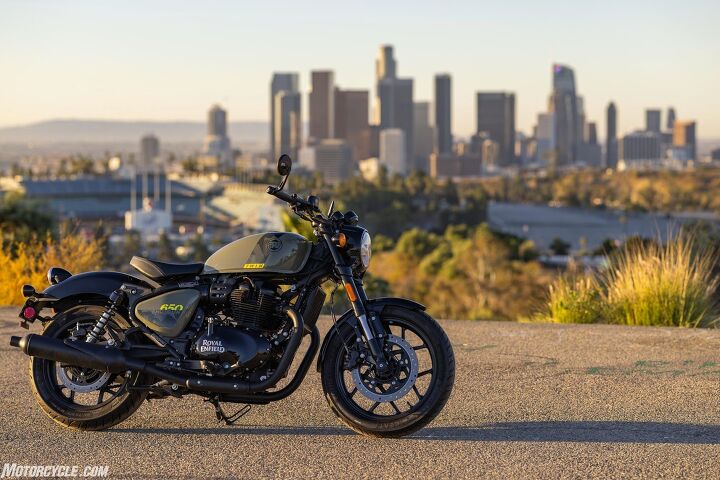











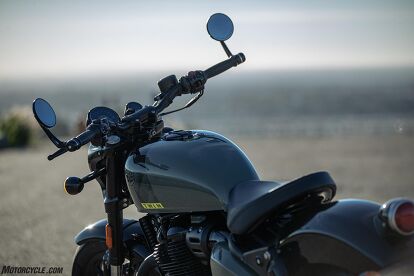




































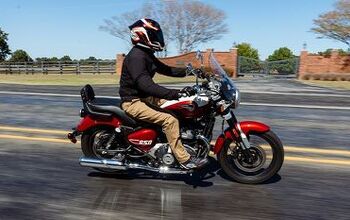
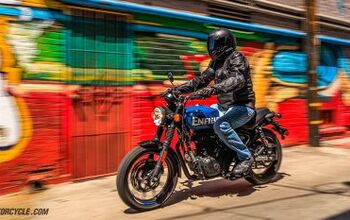
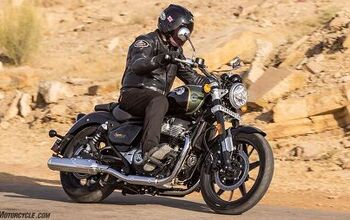












Comments
Join the conversation
This or a Moto Guzzi V7? I could even see it against an MT-07, honestly, if you really want that bobber look and feel!
Harley-Davidson needs to be working on a Nightster 750 with old Sportster levels of performance, it's a good platform and the engine is worth what they're charging but they're pricing out the actual beginners...
Isn't wheelbase measured axle to axle?